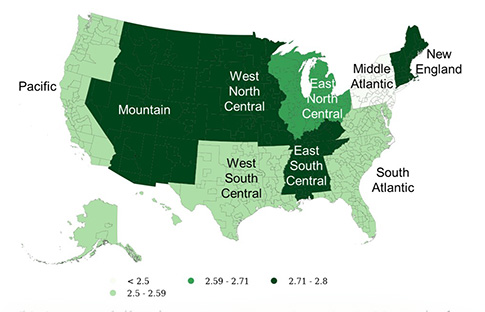An Advance in Travel Demand Analysis
Mobile devices have opened up exciting new research possibilities for researchers studying mobility behavior, as real-time location data can be pulled continuously from these devices in order to obtain a more precise picture of travel in a given area. But such data must also be handled with care, with algorithms put in place to protect privacy and make the data suitable for analysis. Yixuan Pan, who received her doctorate in transportation engineering from the University of Maryland in December 2021, has set out to help address this need. In her doctoral thesis, she put forth a comprehensive set of methods for processing the data gleaned from cell phones and other mobile devices—with a specific focus on origin-destination tables, an important component of travel demand analysis.
“There are limitations to what we can glean from the data itself, however,” she said. “The data is aggregated, not individualized: we can’t zoom down to the individual users and see where you live, where you work, where you go each day. That would be a little creepy, not to mention a breach of privacy. So we use machine learning to impute the actual behavior---that is, make an educated guess. In this way, we’re able to obtain a more accurate picture of travel behavior.” The set of methods proposed by Pan includes data cleaning, activity location and purpose identification, trip-level information identification, social demographic imputation, sample weighting and expansion, and demand validation. For each task, she evaluated state-of-the-practice and algorithms, and developed an applicable method jointly considering the different features of various passive location data sources and the imputation accuracy. She then demonstrated the viability of the method kit in a national-level case study. successfully deriving the national-level origin-destination estimates with additional data products, such as trip rate and vehicle miles traveled, at different geographic levels and temporal resolutions. “I find travel demand analysis particularly interesting because it involves human behavior,” Pan said. “We attempt to model the decisions people make on a day-to-day basis, and these decisions can be affected by very subtle factors. It’s a challenging topic, but I find it fascinating. It’s also of great use to federal and state agencies, because they can use our findings to improve their planning. Having completed her Ph.D., Pan is continuing at UMD as a post-doc, with the aim of developing her research in this area further.
June 6, 2022 Prev Next |



 “We want to generate origin-destination estimates based on passively collected location data and machine learning methods,” Pan explained. “Essentially, we’re using data from devices like phones and smart watches to estimate travel demand.”
“We want to generate origin-destination estimates based on passively collected location data and machine learning methods,” Pan explained. “Essentially, we’re using data from devices like phones and smart watches to estimate travel demand.”